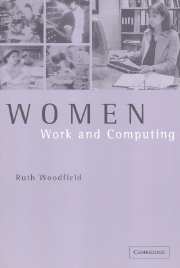Crossref Citations
This Book has been
cited by the following publications. This list is generated based on data provided by Crossref.
Faulkner, Wendy
2000.
The Power and the Pleasure? A Research Agenda for “Making Gender Stick” to Engineers.
Science, Technology, & Human Values,
Vol. 25,
Issue. 1,
p.
87.
Adam, A.
2002.
Knowledge transfer: what are we transferring and where are we transferring it?.
p.
526.
Woodfield, Ruth
2002.
Woman and information systems development: not just a pretty (inter)face?.
Information Technology & People,
Vol. 15,
Issue. 2,
p.
119.
Duplantis, Willa
MacGregor, Eve
Klawe, Maria
and
Ng, Michele
2002.
'Virtual family'.
ACM SIGCSE Bulletin,
Vol. 34,
Issue. 2,
p.
40.
Crews, Thad
and
Butterfield, Jeff
2003.
Gender differences in beginning programming: an empirical study on improving performance parity.
Campus-Wide Information Systems,
Vol. 20,
Issue. 5,
p.
186.
Tapia, Andrea Hoplight
2003.
Hostile_work_environment.com.
p.
64.
Tapia, Andrea H.
and
Kvasny, Lynette
2004.
Recruitment is never enough.
p.
84.
Grey, Susan
and
Healy, Geraldine
2004.
Women and IT contracting work—a testing process.
New Technology, Work and Employment,
Vol. 19,
Issue. 1,
p.
30.
Roldan, Malu
Soe, Louise
and
Yakura, Elaine K.
2004.
Perceptions of chilly IT organizational contexts and their effect on the retention and promotion of women in IT.
p.
108.
Lee, Lisa
2005.
Tackling technology’s image problem among young girls.
International Journal of Sociology and Social Policy,
Vol. 25,
Issue. 10/11,
p.
119.
Belt, Vicki
and
Richardson, Ranald
2005.
Social Labour, Employ ability and Social Exclusion: Pre-employment Training for Call Centre Work.
Urban Studies,
Vol. 42,
Issue. 2,
p.
257.
Wynarczyk, Pooran
McGrath Cohoon, J.
Wu, Zhen
and
You, Wenyi
2006.
International and US citizen women.
Equal Opportunities International,
Vol. 25,
Issue. 8,
p.
629.
Goyal, Ashima
2006.
Developing Women: Why Technology Can Help.
SSRN Electronic Journal,
Wynarczyk, Pooran
Wilson‐Kovacs, Dana M.
Ryan, Michelle
and
Haslam, Alex
2006.
The glass‐cliff: women's career paths in the UK private IT sector.
Equal Opportunities International,
Vol. 25,
Issue. 8,
p.
674.
Adam, Alison
Griffiths, Marie
Keogh, Claire
Moore, Karenza
Richardson, Helen
and
Tattersall, Angela
2006.
Being an ‘it’ in IT: gendered identities in IT work.
European Journal of Information Systems,
Vol. 15,
Issue. 4,
p.
368.
Jubas, Kaela
Butterwick, Shauna
Zhu, Hong
and
Liptrot, Jen
2006.
L/earning a living: practices and recognition of women’s on‐the‐job and informal learning in the information technology field.
Journal of Vocational Education & Training,
Vol. 58,
Issue. 4,
p.
483.
Tapia, Andrea Hoplight
2006.
Hostile work environment.com.
ACM SIGMIS Database: the DATABASE for Advances in Information Systems,
Vol. 37,
Issue. 4,
p.
79.
Brynin, Malcolm
2006.
Gender Equality Through Computerisation.
European Sociological Review,
Vol. 22,
Issue. 2,
p.
111.
Whitehouse, Gillian
and
Diamond, Chris
2006.
Gendered Dichotomies and Segregation Patterns in Computing Jobs in Australia.
Labour & Industry: a journal of the social and economic relations of work,
Vol. 16,
Issue. 3,
p.
73.
Cox, Andrew
2007.
The power and vulnerability of the “new professional”: web management in UK universities.
Program,
Vol. 41,
Issue. 2,
p.
148.



